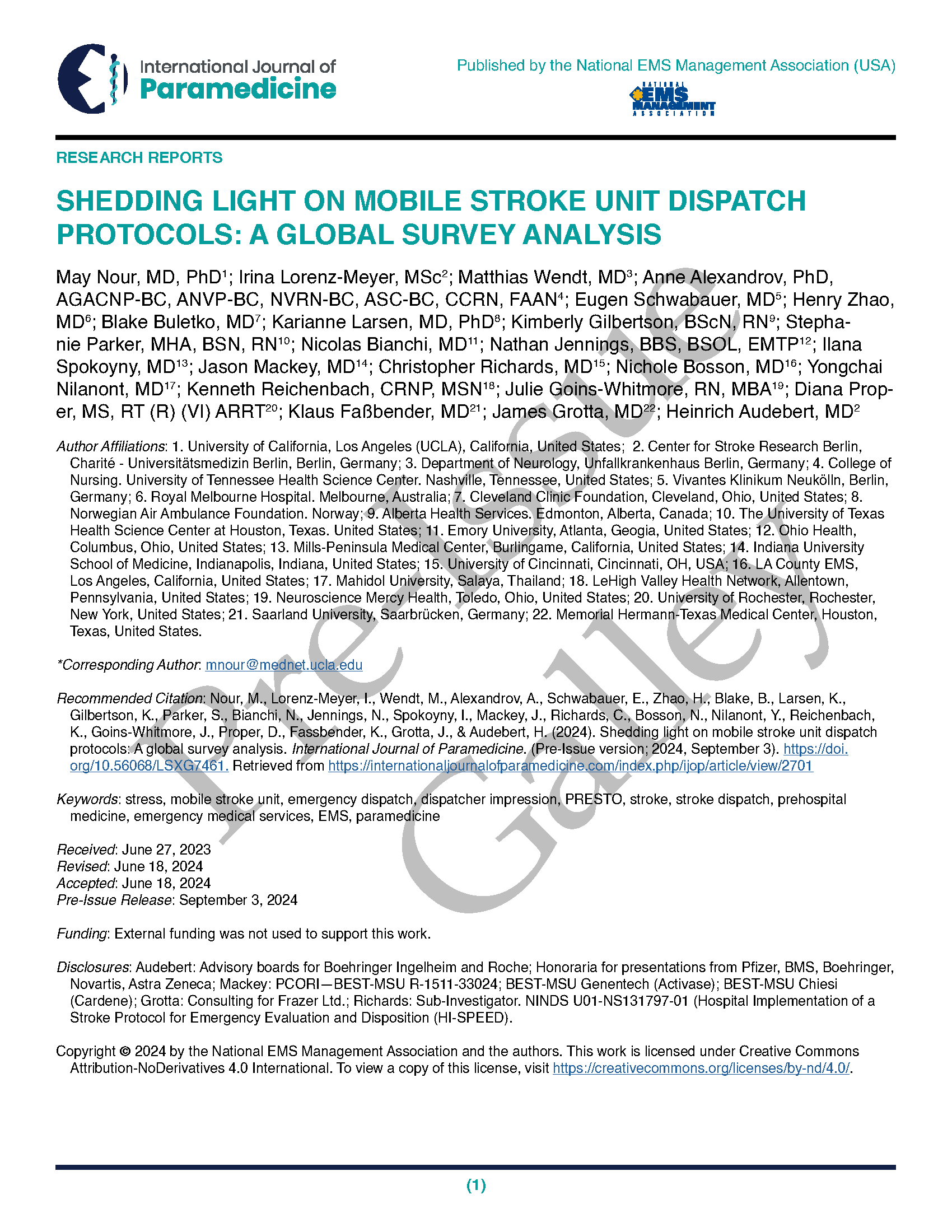Shedding Light on Mobile Stroke Unit Dispatch Protocols A Global Survey Analysis
Main Article Content
Abstract
Background: Treatment on Mobile Stroke Units (MSU) improves outcome for patients with acute ischemic stroke, however MSU effectiveness relies on accuracy of field dispatch. We aimed at collecting representative data on dispatch infrastructure, methods of stroke identification at the dispatcher level, operation rules and accuracy of dispatcher impression relevant to MSU operations worldwide.
Methods: A survey of the PREhospital Stroke Treatment Organization (PRESTO) was conducted in 2020 to include all operational MSU clinical services worldwide. Twenty of 23 MSU services (87%) on four continents responded and participated. We assessed modes of dispatch, level of dispatcher training, numbers of and reasons for dispatches, frequency of MSU cancellation before arrival at scene and diagnoses of patients with MSU management.
Results: All 20 participating MSUs reported dispatching from EMS dispatch centers. Fourteen sites also reported responding to alerts from EMS following patient evaluation. With the exception of 2 MSUs, all reported initial dispatcher training for stroke recognition, but only 6 (30%) performed regular training. Median number of dispatches per year was 325 ranging from 119 to 2174. In addition to dispatches for suspected stroke, 8 (40%) were dispatched to cardiac arrest and 13 (65%) for altered level of consciousness runs. One MSU responded to other dispatch call types including seizure, syncope, headache, sick person, and other, if the call information yielded a suspicion of possible stroke diagnosis. A median of 41% of deployments were cancelled en route. Stroke was excluded in 48% of patients assessed on scene. Eighteen percent of assessed patients were diagnosed with cerebral ischemia within 4.5 hours.
Conclusions: Allocating specialized resources such as MSUs to the most clinically appropriate calls is key to their efficacy and their ability to result in improved patient outcomes. Improving dispatcher recognition of stroke can potentially be ameliorated by local team education and routine feedback.
Article Details

This work is licensed under a Creative Commons Attribution-NoDerivatives 4.0 International License.
Publishing in IJOP allows authors to keep their copyright while giving IJOP unrestricted copyright permissions. Articles published in IJOP use Creative Common Attribution 4.0 International (CC BY-ND 4.0) licensing. This license requires that re-users give credit to the creator. It allows re-users to copy and distribute the material in any medium or format in unadapted form only, even for commercial purposes. Additional terms apply and can be accessed here.
Publishing in IJOP also allows authors to have contracts for non-exclusive distribution of the Journal's published version of the article, such as posting to an institutional repository or publication in a book, on the condition that the original publication in the original layout format in IJOP is retained and acknowledged.
We permit and encourage authors to post the articles they published in IJOP on their affiliated websites. This helps share the information, encourages citation in other works, and promotes scholarly discourse in the spirit of open access.
References
Audebert, H., Fassbender, K., Hussain, M. S., Ebinger, M., Turc, G., Uchino, K., . . . Grotta, J. (2017). The PRE-hospital Stroke Treatment Organization. Int J Stroke, 12(9), 932-940. doi:10.1177/1747493017729268
Ebinger, M., Siegerink, B., Kunz, A., Wendt, M., Weber, J. E., Schwabauer, E., . . . Berlin, P. O. U. D. i. s. c. s. g. (2021). Association Between Dispatch of Mobile Stroke Units and Functional Outcomes Among Patients With Acute Ischemic Stroke in Berlin. JAMA, 325(5), 454-466. doi:10.1001/jama.2020.26345
Ebinger, M., Winter, B., Wendt, M., Weber, J. E., Waldschmidt, C., Rozanski, M., . . . Audebert, H. J. (2014). Effect of the use of ambulance-based thrombolysis on time to thrombolysis in acute ischemic stroke: a randomized clinical trial. JAMA, 311(16), 1622-1631. doi:1861800 [pii]10.1001/jama.2014.2850
Grotta, J. C., Yamal, J. M., Parker, S. A., Rajan, S. S., Gonzales, N. R., Jones, W. J., . . . Bowry, R. (2021). Prospective, Multicenter, Controlled Trial of Mobile Stroke Units. N Engl J Med, 385(11), 971-981. doi:10.1056/NEJMoa2103879
Krebes, S., Ebinger, M., Baumann, A. M., Kellner, P. A., Rozanski, M., Doepp, F., . . . Audebert, H. J. (2012). Development and validation of a dispatcher identification algorithm for stroke emergencies. Stroke, 43(3), 776-781. doi:STROKEAHA.111.634980 [pii]10.1161/STROKEAHA.111.634980
Lees, K. R., Bluhmki, E., von Kummer, R., Brott, T. G., Toni, D., Grotta, J. C., . . . Byrnes, G. (2010). Time to treatment with intravenous alteplase and outcome in stroke: an updated pooled analysis of ECASS, ATLANTIS, NINDS, and EPITHET trials. Lancet, 375(9727), 1695-1703. doi:S0140-6736(10)60491-6 [pii]10.1016/S0140-6736(10)60491-6
Oostema, J. A., Carle, T., Talia, N., & Reeves, M. (2016). Dispatcher Stroke Recognition Using a Stroke Screening Tool: A Systematic Review. Cerebrovasc Dis, 42(5-6), 370-377. doi:10.1159/000447459
Saver, J. L., Goyal, M., van der Lugt, A., Menon, B. K., Majoie, C. B., Dippel, D. W., . . . Collaborators, H. (2016). Time to Treatment With Endovascular Thrombectomy and Outcomes From Ischemic Stroke: A Meta-analysis. JAMA, 316(12), 1279-1288. doi:10.1001/jama.2016.13647
Walter, S., Kostopoulos, P., Haass, A., Keller, I., Lesmeister, M., Schlechtriemen, T., . . . Fassbender, K. (2012). Diagnosis and treatment of patients with stroke in a mobile stroke unit versus in hospital: a randomised controlled trial. Lancet Neurol, 11(5), 397-404. doi:S1474-4422(12)70057-1 [pii]10.1016/S1474-4422(12)70057-1
Weber, J. E., Ebinger, M., Rozanski, M., Waldschmidt, C., Wendt, M., Winter, B., . . . Consortium, S. (2013). Prehospital thrombolysis in acute stroke: results of the PHANTOM-S pilot study. Neurology, 80(2), 163-168. doi:10.1212/WNL.0b013e31827b90e5

